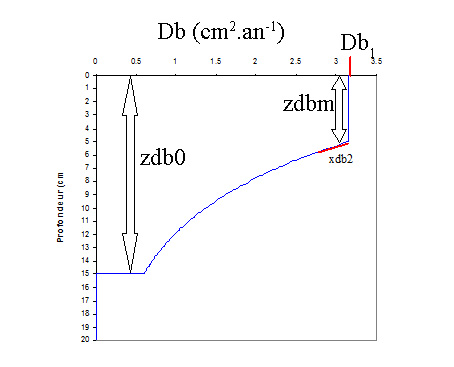Bioturbation within sediment¶
Bioturbation is the result of all activities of the meio and macro-fauna living in the water-sediment interface or in the upper layers of the sediment.
- Bioturbation processes include :
- “surface biodiffusion”
- resulting of benthic organisms living in the first centimeters of the sediment. | Their movement causes the mechanical homogenization of the substrate and randomly in three dimensions;
- “bioirrigation”
- generated by agencies that construct galleries or burrows in the sediment.
These biodiffuseurs gallery provide irrigation sediment creating water currents to respiratory and food purposes.
- “bioadvection”
- induced by organisms that ingest sediment particles in depth (anoxic zone) and discharge their fecal pellets on the sediment surface.
This transport facing up induces a direct link between two non-adjacent geochemical and different strata. The bioadvection may also be downwardly directed
- But in a first step, bioturbation is considered here only as an apparent biodiffusion mixing coefficient Db.
- The coefficient Db at each point and in each sediment layer is evaluated based on an average profile
with a maximum bioturbation intensity (Db1 in m^2.s^-1) near the interface to a specified depth (zdbm, m), then a decrease in depth according to a slope coefficient (xdb2 without unit) to a maximum depth of bioturbation (zdb0 in m), beyond which the bioturbation is considered null (Figure)

Note
These processes are available in MUSTANG but they mus be tested and developped by researchers.
For dissolved substances, bioturbation processes are resolved simultaneously with the diffusion process in the sediment (diffusion routine)
- For particulate substances,
- either bioturbation processes are not involved
- or (to be checked) resolved simultaneously with the consolidation process, but explicitly in time with fractionnary time step; and if consolidation is not taking account, bioturbation for particulate variables are resolved alone in the consolidation routine.
- Parameters for bioturbation are given in paraMUSTANG.txt (namelists for sediment - module MUSTANG)
- l_bioturb : boolean set to .true. si taking into account bioturbation diffusion in sedimentxbioturbmax : max diffusion coefficient by bioturbation Db (in surface)xbioturbk : coef (slope) for bioturbation coefficient between max Db at sediment surface and 0 at bottomdbiotu0 : max depth beneath the sediment surface below which there is no bioturbationdbiotum : sediment thickness wherein the diffusion-bioturbation coefficient Db is constant (max)frmud_db_min : mud fraction limit (min) below which there is no Bioturbationfrmud_db_max : mud fraction limit (max) above which the bioturbation coefficient Db is maximum (muddy sediment)
